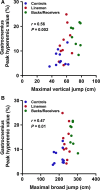Comparison of regional skeletal muscle tissue oxygenation in college athletes and sedentary control subjects using quantitative BOLD MR imaging
- PMID: 27535483
- PMCID: PMC5002911
- DOI: 10.14814/phy2.12903
Comparison of regional skeletal muscle tissue oxygenation in college athletes and sedentary control subjects using quantitative BOLD MR imaging
Abstract
Blood oxygen level-dependent (BOLD) magnetic resonance (MR) imaging permits noninvasive assessment of tissue oxygenation. We hypothesized that BOLD imaging would allow for regional evaluation of differences in skeletal muscle oxygenation between athletes and sedentary control subjects, and dynamic BOLD responses to ischemia (i.e., proximal cuff occlusion) and reactive hyperemia (i.e., rapid cuff deflation) would relate to lower extremity function, as assessed by jumping ability. College football athletes (linemen, defensive backs/wide receivers) were compared to sedentary healthy controls. BOLD signal of the gastrocnemius, soleus, anterior tibialis, and peroneus longus was assessed for peak hyperemic value (PHV), time to peak (TTP), minimum ischemic value (MIV), and time to recovery (TTR). Significantly higher PHVs were identified in athletes versus controls for the gastrocnemius (linemen, 15.8 ± 9.1%; defensive backs/wide receivers, 17.9 ± 5.1%; controls, 7.4 ± 3.5%), soleus (linemen, 25.9 ± 11.5%; backs/receivers, 22.0 ± 9.4%; controls, 12.9 ± 5.8%), and anterior tibialis (linemen, 12.8 ± 5.3%; backs/receivers, 12.6 ± 3.9%; controls, 7.7 ± 4.0%), whereas no differences in PHV were found for the peroneus longus (linemen, 14.1 ± 6.9%; backs/receivers, 11.7 ± 4.6%; controls, 9.0 ± 4.9%). In all subject groups, the gastrocnemius and soleus muscles exhibited the lowest MIVs during cuff occlusion. No differences in TTR were found between muscles for any subject group. PHV of the gastrocnemius muscle was significantly and positively related to maximal vertical (r = 0.56, P = 0.002) and broad jump (r = 0.47, P = 0.01). These results suggest that BOLD MR imaging is a useful noninvasive tool for evaluating differences in tissue oxygenation of specific muscles between active and sedentary individuals, and peak BOLD responses may relate to functional capacity.
Keywords: Blood oxygen level dependent; exercise training; magnetic resonance imaging; tissue oxygenation; vascular function.
© 2016 The Authors. Physiological Reports published by Wiley Periodicals, Inc. on behalf of the American Physiological Society and The Physiological Society.
Figures




Similar articles
-
Simultaneous dynamic blood oxygen level-dependent magnetic resonance imaging of foot and calf muscles: aging effects at ischemia and postocclusive hyperemia in healthy volunteers.Invest Radiol. 2009 Nov;44(11):741-7. doi: 10.1097/RLI.0b013e3181b248f9. Invest Radiol. 2009. PMID: 19809343
-
Application of BOLD Magnetic Resonance Imaging for Evaluating Regional Volumetric Foot Tissue Oxygenation: A Feasibility Study in Healthy Volunteers.Eur J Vasc Endovasc Surg. 2016 May;51(5):743-9. doi: 10.1016/j.ejvs.2016.02.008. Epub 2016 Mar 9. Eur J Vasc Endovasc Surg. 2016. PMID: 26970710 Free PMC article.
-
Dynamic Blood Oxygen Level-dependent MR Imaging of Muscle: Comparison of Postocclusive Reactive Hyperemia in Young Smokers and Nonsmokers.Magn Reson Med Sci. 2015;14(4):275-83. doi: 10.2463/mrms.2014-0105. Epub 2015 May 19. Magn Reson Med Sci. 2015. PMID: 25994035
-
Clinical implications of skeletal muscle blood-oxygenation-level-dependent (BOLD) MRI.MAGMA. 2012 Aug;25(4):251-61. doi: 10.1007/s10334-012-0306-y. Epub 2012 Feb 29. MAGMA. 2012. PMID: 22374263 Review.
-
Skeletal muscle BOLD MRI: from underlying physiological concepts to its usefulness in clinical conditions.J Magn Reson Imaging. 2012 Jun;35(6):1253-65. doi: 10.1002/jmri.23536. J Magn Reson Imaging. 2012. PMID: 22588992 Review.
Cited by
-
Cardiovascular aging and the microcirculation of skeletal muscle: using contrast-enhanced ultrasound.Am J Physiol Heart Circ Physiol. 2018 Nov 1;315(5):H1194-H1199. doi: 10.1152/ajpheart.00737.2017. Epub 2018 Aug 3. Am J Physiol Heart Circ Physiol. 2018. PMID: 30074839 Free PMC article.
-
Measurement of Tissue Oxygen as a Novel Approach to Optimizing Red Blood Cell Quality Assessment.Adv Exp Med Biol. 2021;1269:379-386. doi: 10.1007/978-3-030-48238-1_60. Adv Exp Med Biol. 2021. PMID: 33966246
-
Clinical physiology: the crucial role of MRI in evaluation of peripheral artery disease.Am J Physiol Heart Circ Physiol. 2024 May 1;326(5):H1304-H1323. doi: 10.1152/ajpheart.00533.2023. Epub 2024 Mar 22. Am J Physiol Heart Circ Physiol. 2024. PMID: 38517227 Free PMC article. Review.
-
Dynamic characteristics of T2*-weighted signal in calf muscles of peripheral artery disease during low-intensity exercise.J Magn Reson Imaging. 2017 Jul;46(1):40-48. doi: 10.1002/jmri.25532. Epub 2016 Oct 26. J Magn Reson Imaging. 2017. PMID: 27783446 Free PMC article.
-
Molecular Imaging of Lower Extremity Peripheral Arterial Disease: An Emerging Field in Nuclear Medicine.Front Med (Lausanne). 2022 Jan 12;8:793975. doi: 10.3389/fmed.2021.793975. eCollection 2021. Front Med (Lausanne). 2022. PMID: 35096884 Free PMC article.
References
-
- Brooke, M. H. , and Kasier K. K.. 1970. Three “myosin ATPase” systems: the nature of their pH liability and sulphydryl dependence. J. Histochem. Cytochem. 18:670–672. - PubMed
-
- Costill, D. L. , Daniels J., Evans W., Fink W., and Krahenbuhl G.. 1976. Skeletal muscle enzymes and fiber composition in male and female track athletes. J. Appl. Physiol. 40:149–154. - PubMed
-
- Engel, W. K. 1962. The essentiality of histo‐ and cytochemical studies of skeletal muscle in the investigation of neuromuscular disease. Neurology 12:778–784. - PubMed
-
- Fink, W.J. , Costill D. L., and Pollock M. L.. 1977. Submaximal and maximal working capacity of elite distance runners. Part II: muscle fiber composition and enzyme activities. Ann. N. Y. Acad. Sci. 301:323–327. - PubMed
Publication types
MeSH terms
Substances
Grants and funding
LinkOut - more resources
Full Text Sources
Other Literature Sources
Medical
Research Materials
Miscellaneous

